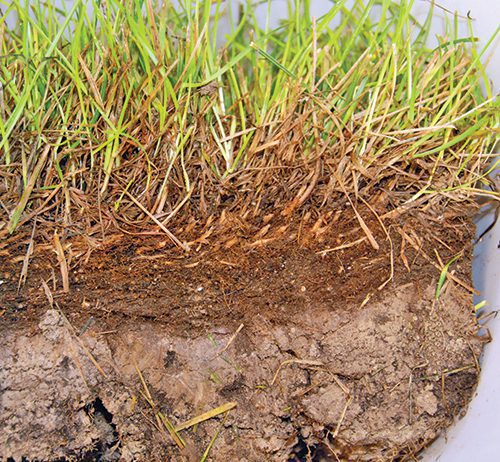Well hello, it’s that time of year again. Time to get your lawn ready for another fun-filled summer. What’s the first thing to do? Dethatch and aerate.
What’s Dethatching?

Thatch is dead or decaying organic matter (stems, roots, and runners) that forms a light brown layer between the live grass and the soil after a few years. (Grass clippings don’t make thatch–their high water content makes them decay quickly.) A little thatch is actually a good thing; it conserves water, protects the soil, holds the grass up better and makes the lawn springy. Too much thatch, though, is a problem–it can make it hard for the grass to root and can make a hiding place for disease and pests.
You have too much thatch if: your lawn feels soft, has dry spots after watering, looks brown after mowing, or thins out and starts to die even with fertilizer.
You can measure your thatch by either sticking a screwdriver or wire into your lawn and measuring how far it is till you hit soil, or you can cut a few wedges out of your lawn with a small knife and measuring the distance between the soil and the grass. If you’ve got more than 1/2 in. (1.27 cm) start dethatching!
How Do I Dethatch My Lawn?
 In a small lawn, you can manually rake the thatch out with a leaf rake, hoe, hard rake, or dethatching rake. Just rake the stuff up from under the grass and get rid of it. If you’re lawn’s bigger, you probably want to rent a power dethatcher; chemicals are ineffective and lawnmower attachments put too much strain on the mower.
In a small lawn, you can manually rake the thatch out with a leaf rake, hoe, hard rake, or dethatching rake. Just rake the stuff up from under the grass and get rid of it. If you’re lawn’s bigger, you probably want to rent a power dethatcher; chemicals are ineffective and lawnmower attachments put too much strain on the mower.
Renting these machines makes sense–they’re expensive and you only need them at most twice a year. (See our “Why Rent?” page.)
 Dethatchers come with several kinds of blades: wire tines, rotating flails, or fixed knife-like blades. Each kind is good for different grasses. When you pick up your machine, ask us for advice about how far apart and deep to set the blades for your grasses. As a rule of thumb, 1″-2″ inches (2-2.5 cm) apart is fine for tough grass, 3 inches or more for delicate ones. To remove thatch without tearing up the ground (your goal), a height of about 1/4 inch (6.35 mm) is a good place to start. Adjust the machine on a smooth surface such as you driveway.
Dethatchers come with several kinds of blades: wire tines, rotating flails, or fixed knife-like blades. Each kind is good for different grasses. When you pick up your machine, ask us for advice about how far apart and deep to set the blades for your grasses. As a rule of thumb, 1″-2″ inches (2-2.5 cm) apart is fine for tough grass, 3 inches or more for delicate ones. To remove thatch without tearing up the ground (your goal), a height of about 1/4 inch (6.35 mm) is a good place to start. Adjust the machine on a smooth surface such as you driveway.
Keep in mind that these things are heavy–you’ll want help loading and unloading.
Mow your lawn half as high as usual, then run the dethatcher over your lawn a few times, changing your direction each pass. Rake up all the loose thatch; you may get as much as one or two pickup loads for an average-size lawn! If you haven’t used herbicides or pesticides, you can reuse the thatch as mulch or compost. Otherwise discard.
Spring is the best time to dethatch in our par of the country, as you need at least 45 growing days for the grass to recover and grow back from the drastic effects of dethatching. Planting grasses that don’t produce a lot of thatch, regularly dethatching twice a year to once every two years, encouraging earthworms (stay away from pesticides as much as possible), avoiding over-watering or over-fertilizing (use slow-release nitrogen fertilizer), and mowing regularly but not too much all helps keep thatch down. Ask us for advice–we have extensive experience in the lawn care and landscaping business.

